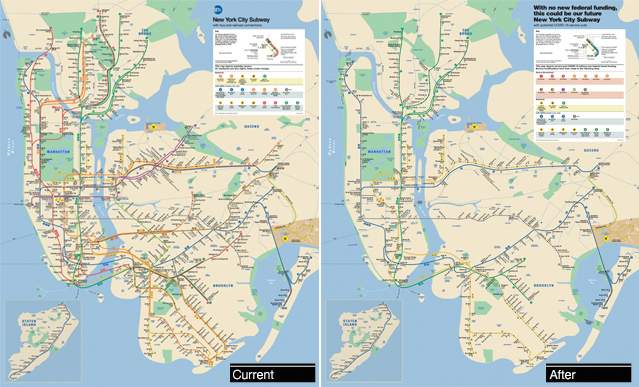If the federal fails to pass a new transit relief package, the MTA will be forced to do one of three things, all of which are bad: fully eliminate 12 subway lines, eliminate all buses and commuter rail service to keep full subway service, or gut subway and bus service so dramatically that crowding would likely lead to a second wave of COVID-19, advocates said on Wednesday.
The three scenarios are laid out in a Riders Alliance report, "Doomsday on the MTA," that uses the math of the MTA's 2010 post-recession service cuts as a model for how the agency would plug its current multi-billion-dollar shortfall if the feds don't rubber stamp an emergency request for $3.9 billion to cover revenue losses through 2020.
In 2010, the MTA made $400 million in cuts, including eliminating the V and W subway lines and cutting or shortening 110 bus lines. Following that same brutal math, the Riders Alliance calculates that the agency would have to cut all service on the 1, 2, 3, 7, B, D, F, M, G, J, and Z lines and the Franklin Avenue S (also known as the Toot Scoot).
As the above map demonstrates, the move would save the MTA $650 million per month, but it would create a city whose underground system would be unrecognizable and whose neighborhoods are largely cut off from the subway service they have depended on for decades:
- Corona, Queens, which has been devastated by coronavirus because of its high population of essential workers, and Flushing would be particularly screwed over by the loss of the 7 train.
- The Upper West Side would be left with just the C train running along Central Park.
- Brooklynites would have no G train for cross-borough service.
- Riverdale and Kingsbridge in the Bronx would be completely shut out of subway service.
The service cuts would result in less ridership, which starts the so-called death spiral: fewer riders result in less farebox revenue, which forces the agency to make more cuts, which leads to fewer riders. Cuts to bus service in 2010, for instance, resulted in a 15-percent drop in bus ridership.
The MTA is not close to recovering its pre-pandemic ridership, with subway numbers approaching around 20 percent of normal daily ridership. That's an improvement from the depths of the coronavirus, when subway ridership dropped about 90 percent, but the report points out that no one will rush back to worse service if that's all that's offered.
Cutting 12 subway lines entirely is not the only possible outcome; Riders Alliance also war-gamed two additional scenarios that save the agency roughly the same amount of money (but aren't as visually compelling as a subway map with no subways):
- In one scenario, the MTA would completely eliminate express trains, and lengthen the headways on rush hour trains to 10 to 15 minutes (and 20 to 30 minutes off-peak). Buses and commuter rail frequency would be cut proportionately. The resulting crowding is the stuff of nightmares (even before a highly contagious virus is factored into the equation).
- In the other scenario, the subway remains untouched, at the cost of literally ever single other service the MTA provides outside of Access-A-Ride. That means no more bus service or commuter rail at a time when the city is still counting on office workers to eventually return to work.
"Since large majorities of subway and bus riders are Black and Brown New Yorkers, transit service cuts also would inflict a severe, lasting, new racial injustice," the advocates wrote in their report. "The cuts could hardly come at a worse time, immediately on the heels of COVID’s racial disparate devastation and a resurgent movement for Black lives following several police murders of unarmed Black Americans."
The scenarios are very literally worst-case scenarios if Congress sits back and allows the financial collapse of America's largest transit agency, but the threats to the agency are very real. In addition the Riders Alliance report, the New York City Independent Budget Office put out a report which laid out the choppy fiscal water the MTA will have to make it through in the coming years. The IBO now estimates that the dedicated tax revenues on which the MTA relies, including various city tax revenue and the state mortgage recording tax, are going to provide $2.7 billion less than revenue than the IBO originally projected for 2020, 2021 and 2022.
In the House, Democrats have passed a transit bailout that would give $11.75 billion to the largest transit agencies in the country, including the $3.9 billion, or 33 percent, to the MTA, which carries 38 percent of the nation's mass transit trips.
But the Republican-controlled Senate has yet to pass its own coronavirus relief bill. That may change as the virus continues to blaze through three-quarters of the country, but Senate Majority Leader Mitch McConnell has stated that his main focus of another relief bill is giving immunity to businesses that give their employees and customers coronavirus. (His office did not respond to a request for comment.)
The MTA used the opportunity to once again remind Congress to do its job, though it did not comment on the specific scenarios laid out in the Riders Alliance report.
"The MTA is facing the most acute financial crisis in its history with dangerous shortfalls to revenue from fares and taxes," said MTA spokesman Aaron Donovan. "We have urgently requested $3.9 billion in emergency funding from Congress to get us through the remainder of 2020 and we need the Senate to return to Washington, do its job and provide this funding now. The future of New York City and our nation's economy depends on it."







